A Guide to the Cuts of Beef Part Eight
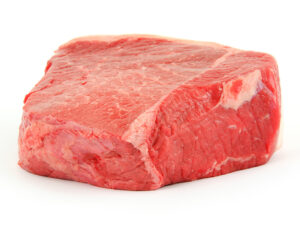
The Purpose of the Post:
In my previous blog post, ‘A Guide to the Cuts of Beef Part Seven,’ I only began to delve into the diverse array of cuts that originate from the Round section of a cow’s hindquarter. In this installment, I will thoroughly explore the remaining cuts from this section. If you missed my previous blog post, you can read it https://fireinthekettle.com/a-guide-to-the-cuts-of-beef-part-seven/. Additionally, if you haven’t already, I recommend checking out my earlier posts on beef cuts, starting from ‘A Guide to the Cuts of Beef Part Four’ https://fireinthekettle.com/a-guide-to-the-cuts-of-beef-part-four/. Each post builds upon the last, offering a comprehensive understanding of the topic. While I strive to make each blog post informative and clear, the series as a whole provides a more cohesive picture of the subject matter.
The Heel of Round:
The Heel of Round is typically the next cut removed from the Round after the Femur Bone. Often, butchers or meat processors reserve this portion for Ground Beef. It’s important to note that the Heel of Round is relatively small and less tender than other parts of the round, containing more connective tissue and potentially less marbling. Despite this, when prepared correctly, the heel can still yield flavorful and versatile dishes. It’s well-suited for slow cooking methods such as braising or stewing, where the connective tissue breaks down over time, resulting in tender and flavorful meals. While the Heel of Round may not be as widely known or sought after as other cuts, it remains a valuable and economical option for various culinary applications. After removing the Heel of Round, butchers or processors typically proceed to remove the Top Round.
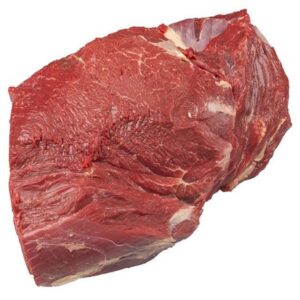
The Top Round:
After removing the Top Round, butchers or meat processors typically proceed to remove the Eye-of-Round. From the Top Round, some butchers or processors may cut London Broils, leaving the fat cap intact for this purpose. They then square up the Top Round, reserving a portion for jerky before cutting the London Broil. It’s important to note that the thickness of the London Broil is usually around two inches, adjusted based on the size of the Top Round. However, it’s crucial to understand that “London Broil” refers to a cooking method rather than a specific cut of meat. Typically, this involves marinating and then broiling or grilling a lean and flavorful beef cut. The Top Round is often preferred for its leanness, benefiting from marination to enhance tenderness and flavor. Thinly slicing the cooked Top Round against the grain results in a delicious dish. Consumers should inquire about the specific cut used, as London Broil can also come from the Bottom Round.

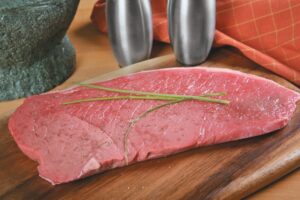
Beef Jerky:
The Top Round is an excellent choice for making beef jerky. To prepare beef jerky using Top Round, begin by partially freezing the meat to facilitate thin and uniform slicing. Using a sharp knife, slice the partially frozen top round against the grain into strips, aiming for a thickness of about 1/8 to 1/4 inch. Remove any excess fat or connective tissue from the strips. Then, marinate the strips in a mixture of desired seasonings, spices, and marinade ingredients for several hours or overnight in the refrigerator to allow the flavors to infuse the meat.
After marinating, remove the strips from the marinade and pat them dry with paper towels to remove excess moisture. Arrange the strips on wire racks or dehydrator trays and dry them in a low-temperature oven or food dehydrator until they reach the desired texture, typically requiring 4 to 6 hours. It’s important to ensure thorough drying to prevent spoilage.
Once dried, allow the beef jerky to cool completely before storing it in an airtight container for an extended shelf life. Properly stored, homemade beef jerky can last for several weeks.
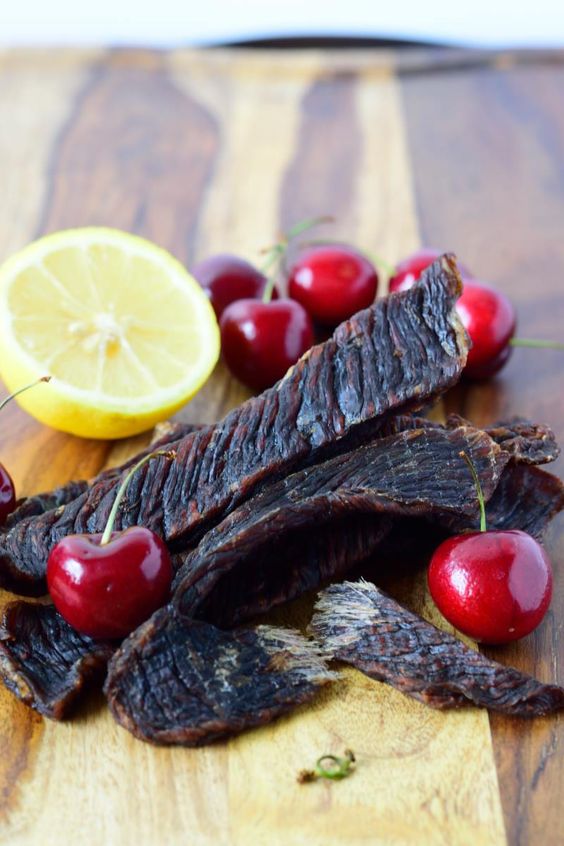
The Eye-of-Round:
After removing the Eye-of-Round, the butcher or meat processor proceeds to remove the Bottom Round. It’s important to note that these cuts are typically separated using a semi-stiff boning knife, usually six to eight inches in length. Based on my experience, the eight-inch semi-stiff boning knife is often preferred for this task.
The Eye-of-Round does contain some fat, and leaving a generous amount of fat cover on this cut is common practice among butchers or processors. This fat contributes to flavor and juiciness, as fat is known to enhance taste. The Eye-of-Round is often reserved for roasts due to high consumer demand for this type of preparation.
It’s essential to understand that the Eye-of-Round is a very lean cut of beef, containing less intramuscular fat compared to cuts like ribeye or sirloin. Consequently, it tends to be less tender. However, slicing it thinly against the grain can help maximize tenderness, making it suitable for dishes such as stir-fries or beef stroganoff.
When cooked low and slow, the Eye-of-Round roast can become tender and juicy, much like the Bottom Round. Both cuts are ideal for smoking in a smoker, but it’s crucial to marinate or apply a dry rub and allow them to rest overnight for optimal flavor infusion.
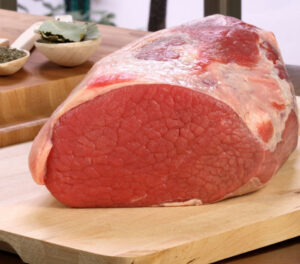
The Bottom Round:
After removing the Heel-of-Round, Top Round, and Eye-of-Round, the butcher or meat processor is left with the Bottom Round. Some trimming of fat located on the side of the Bottom Round is typically performed by the butcher or processor. It’s important to note that there is a large piece of gristle often present on the side of the Bottom Round, which the butcher or processor will remove.
Depending on preferences, the butcher or processor may choose to cut the Bottom Round into Stew Meat or Roasts. However, it’s essential to understand that the Bottom Round is generally tougher compared to other cuts from the round primal. This is because it’s a well-exercised muscle located near the hind leg of the animal, containing more connective tissue and less fat marbling.
The Bottom Round is well-suited for the Low and Slow Indirect cooking method. Cooking it using this method helps break down the connective tissue over time, resulting in a more tender and flavorful end product. Compared to Brisket, the Bottom Round is a more economical choice for Low and Slow cooking.
Other cuts that can come from the Bottom Round include London Broil if thinly sliced, beef jerky, and lean ground beef. It’s commonly used for lean ground beef due to its low-fat content.

In Closing:
As we conclude our exploration into the various cuts of beef from both the front and hindquarters, we’ve gained a deeper understanding of the richness and versatility of this meat. From the flavorful ribeye to the lean bottom round, each cut offers unique qualities and culinary possibilities. I trust that these insights have empowered you as a more informed consumer when navigating your butcher’s offerings. Looking ahead, I’m excited to continue our journey by providing a condensed overview of all the cuts from a half side of a cow, followed by practical demonstrations of smoking and cooking techniques on my YouTube channel. Your feedback and engagement are invaluable, so please share your thoughts with us. Thank you for joining me on this enlightening journey!
